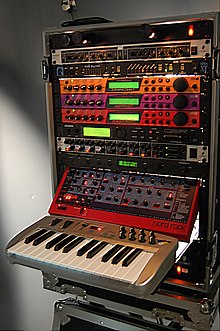
Back ميدي (حاسوب) Arabic MIDI Azerbaijani MIDI BAR MIDI Bulgarian MIDI BS MIDI Catalan Musical Instrument Digital Interface Czech MIDI Danish MIDI German MIDI Greek
This article may be too technical for most readers to understand. (November 2018) |


MIDI (/ˈmɪdi/; Musical Instrument Digital Interface) is a technical standard that describes a communication protocol, digital interface, and electrical connectors that connect a wide variety of electronic musical instruments, computers, and related audio devices for playing, editing, and recording music.[1]
A single MIDI cable can carry up to sixteen channels of MIDI data, each of which can be routed to a separate device. Each interaction with a key, button, knob or slider is converted into a MIDI event, which specifies musical instructions, such as a note's pitch, timing and loudness. One common MIDI application is to play a MIDI keyboard or other controller and use it to trigger a digital sound module (which contains synthesized musical sounds) to generate sounds, which the audience hears produced by a keyboard amplifier. MIDI data can be transferred via MIDI or USB cable, or recorded to a sequencer or digital audio workstation to be edited or played back.[2]
MIDI also defines a file format that stores and exchanges the data. Advantages of MIDI include small file size, ease of modification and manipulation and a wide choice of electronic instruments and synthesizer or digitally sampled sounds.[3]: 4 A MIDI recording of a performance on a keyboard could sound like a piano or other keyboard instrument; however, since MIDI records the messages and information about their notes and not the specific sounds, this recording could be changed to many other sounds, ranging from synthesized or sampled guitar or flute to full orchestra.
Before the development of MIDI, electronic musical instruments from different manufacturers could generally not communicate with each other. This meant that a musician could not, for example, plug a Roland keyboard into a Yamaha synthesizer module. With MIDI, any MIDI-compatible keyboard (or other controller device) can be connected to any other MIDI-compatible sequencer, sound module, drum machine, synthesizer, or computer, even if they are made by different manufacturers.
MIDI technology was standardized in 1983 by a panel of music industry representatives, and is maintained by the MIDI Manufacturers Association (MMA). All official MIDI standards are jointly developed and published by the MMA in Los Angeles, and the MIDI Committee of the Association of Musical Electronics Industry (AMEI) in Tokyo. In 2016, the MMA established The MIDI Association (TMA) to support a global community of people who work, play, or create with MIDI.[4]
- ^ Swift, Andrew. (May 1997), "A brief Introduction to MIDI", SURPRISE, Imperial College of Science Technology and Medicine, archived from the original on 30 August 2012, retrieved 22 August 2012
- ^ Cite error: The named reference
Huber 1991was invoked but never defined (see the help page). - ^ "What is MIDI?". Archived from the original on 16 June 2016. Retrieved 31 August 2016.
- ^ samples, Electronic Musician – featuring gear reviews, audio tutorials, loops and. "The MIDI Association Launches at NAMM 2016". Archived from the original on 14 October 2016. Retrieved 31 August 2016.
{{cite web}}: CS1 maint: multiple names: authors list (link)
© MMXXIII Rich X Search. We shall prevail. All rights reserved. Rich X Search